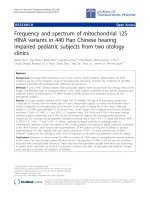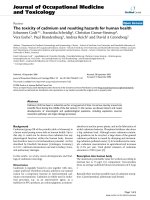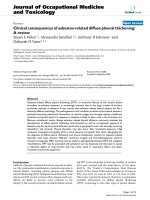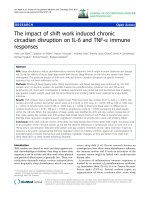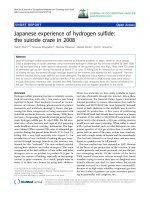Báo cáo hóa học: " Frequency Shift of Carbon-Nanotube-Based Mass Sensor Using Nonlocal Elasticity Theory" ppt
Bạn đang xem bản rút gọn của tài liệu. Xem và tải ngay bản đầy đủ của tài liệu tại đây (348.08 KB, 5 trang )
NANO EXPRESS
Frequency Shift of Carbon-Nanotube-Based Mass Sensor Using
Nonlocal Elasticity Theory
Haw-Long Lee
•
Jung-Chang Hsu
•
Win-Jin Chang
Received: 15 May 2010 / Accepted: 19 July 2010 / Published online: 1 August 2010
Ó The Author(s) 2010. This article is published with open access at Springerlink.com
Abstract The frequency equation of carbon-nanotube-
based cantilever sensor with an attached mass is derived
analytically using nonlocal elasticity theory. According to
the equation, the relationship between the frequency shift
of the sensor and the attached mass can be obtained.
When the nonlocal effect is not taken into account, the
variation of frequency shift with the attached mass on the
sensor is compared with the previous study. According to
this study, the result shows that the frequency shift of the
sensor increases with increasing the attached mass. When
the attached mass is small compared with that of the
sensor, the nonlocal effect is obvious and increasing
nonlocal parameter decreases the frequency shift of the
sensor. In addition, when the location of the attached
mass is closer to the free end, the frequency shift is more
significant and that makes the sensor reveal more sensi-
tive. When the attached mass is small, a high sensitivity is
obtained.
Keywords Carbon nanotube Á Mass sensor Á
Nonlocal elasticity theory Á Frequency shift
Introduction
Carbon nanotube (CNT) have many potential applications in
nanobiological devices and nanomechanical systems
because of excellent mechanical properties, chemical and
thermal stability, and hollow geometry [1–4]. In addition, the
CNT is ultralight and is highly sensitive to its environment
changes. Therefore, many researchers have explored the
potential of using CNT as nanomechanical resonators in
atomic-scale mass sensor [5–7]. For example, Chiu et al. [6]
utilized the detection of shifts in the resonance frequency of
the nanotubes to measure nanotube resonator vibration
characteristics.
The atomic-scale mass sensing with a resonator is based
on the fact that the resonant frequency is sensitive to the
attached mass. The attached mass causes a shift to the res-
onant frequency of resonator. In addition, the shift in reso-
nant frequency is associated with the location of attached
mass. To analyze the effects of adsorbed mass and its loca-
tion on the resonant frequency of CNT, the continuum
models based on beam as well as shell was used [8].
Recently, Dai et al. [9] studied the nanomechanical mass
detection using nonlinear oscillators based on continuum
elastic model and obtained that nonlinear oscillation leads to
the unique resonant frequency shift due to mass adsorption,
quite different from that in harmonic oscillation. The ulti-
mate goal of a resonator sensor is single molecule detection
capability. Chowdhury et al. [10] presented an equivalent
approximation model to analyze frequency shift of a single-
walled carbon nanotube (SWCNT) due to an attached par-
ticle fixed at a location.
It is more useful fora mass sensor to simultaneously detect
the mass and position of the attached particle. In this Letter,
frequency shift of carbon-nanotube-based sensor with an
attached mass is studied using nonlocal elasticity theory,
which is a modified classical elasticity theory. This theory
with long-range interactions is often applied to analyze the
vibration behaviour of CNT [11–13]. In addition, the effects
of nonlocal parameter, attached mass and its location on the
frequency shift of a cantilevered SWCNT are analyzed.
H L. Lee Á J C. Hsu Á W J. Chang (&)
Department of Mechanical Engineering, Kun Shan University,
Tainan 71003, Taiwan
e-mail:
123
Nanoscale Res Lett (2010) 5:1774–1778
DOI 10.1007/s11671-010-9709-8
Analysis
A schematic diagram of a SWCNT with an attached mass
M located at c from the fixed end is described as a can-
tilever beam as depicted in Fig. 1. The SWCNT with
length L has an equivalent bending rigidity EI, the volume
density q, the cross-sectional area A, and transverse dis-
placement Y depend on the spatial coordinate X and time
t. Based on nonlocal elasticity theory [14], the governing
equation of transverse vibration for the SWCNT can be
expressed as
EI
o
4
Y
oX
4
þ 1 Àðe
0
aÞ
2
o
2
oX
2
!
qA
o
2
Y
ot
2
¼ 0 ð1Þ
where e
0
a is the nonlocal parameter, and it is used to
modify the classical elasticity theory and is limited to apply
to a device on the nanometer scale.
The harmonic solution of the governing equation can be
assumed as
YðX; tÞ¼WðXÞe
ixt
ð2Þ
where x is the angular frequency.
By introducing the dimensionless parameters x = X/L,
and substituting Eq. 2 into Eq. 1, one obtain
d
4
w
dx
4
þ ck
2
d
2
w
dx
2
À k
4
w ¼ 0 ð3Þ
where
k
4
¼
qAL
4
EI
x
2
; c ¼ e
2
k
2
; e ¼
e
0
a
L
: ð4Þ
The corresponding boundary conditions are
w
1
ð0Þ¼
dw
1
ð0Þ
dx
¼ 0 ð5Þ
d
2
w
2
ð1Þ
dx
2
þ ck
2
w
2
ð1Þ¼0 ð6Þ
d
3
w
2
ð1Þ
dx
3
þ ck
2
dw
2
ð1Þ
dx
¼ 0 ð7Þ
w
1
ðnÞ¼w
2
ðnÞð8Þ
dw
1
ðnÞ
dx
¼
dw
2
ðnÞ
dx
ð9Þ
d
2
w
1
ðnÞ
dx
2
þ ck
2
w
1
ðnÞ¼
d
2
w
2
ðnÞ
dx
2
þ ck
2
w
2
ðnÞð10Þ
d
3
w
1
ðnÞ
dx
3
þ ck
2
dw
1
ðnÞ
dx
À
d
3
w
2
ðnÞ
dx
3
þ ck
2
dw
2
ðnÞ
dx
!
þ mk
4
w
1
ðnÞ
¼ 0
ð11Þ
where m = M/qAL and n = c/L are the dimensionless
mass and position of the attached mass, respectively; w
1
and w
2
are the dimensionless transverse displace-
ments on the left and right sides of the attached mass,
respectively.
The boundary conditions given by Eq. 5 correspond to
conditions of zero displacement and the zero slope at fixed
end (x = 0), Eqs. 6 and 7 are zero moment and the zero
shear force at free end (x = 1), respectively. Eqs. 8, 9, 10
and 11 are the compatibility conditions at the location of
the attached mass [15].
The general solutions of Eq. 3 for the SWCNT with
attached mass are
w
1
ðxÞ¼C
1
cos kax þC
2
sin kax þC
3
cosh kbx
þ C
4
sinh kbx ð12Þ
w
2
ðxÞ¼C
5
cos kax þC
6
sin kax þC
7
cosh kbx
þ C
8
sinh kbx ð13Þ
where
a ¼
ffiffiffiffiffiffiffiffiffiffiffiffiffiffiffiffiffiffiffiffiffiffiffiffiffi
ffiffiffiffiffiffiffiffiffiffiffiffiffi
4 þc
2
p
þ c
2
s
; b ¼
ffiffiffiffiffiffiffiffiffiffiffiffiffiffiffiffiffiffiffiffiffiffiffiffiffi
ffiffiffiffiffiffiffiffiffiffiffiffiffi
4 þc
2
p
À c
2
s
: ð14Þ
and C
1
, C
2
, C
3
,…C
8
are constants.
Substituting Eqs. 12 and 13 into Eqs. 5, 6, 7, 8, 9, 10
and 11, we can obtain the following matrix form:
A½ C
fg
¼ 0 ð15Þ
where
L
Y
X
c
M
Fig. 1 A cantilevered nanotube-based mass sensor with an attached
mass
Nanoscale Res Lett (2010) 5:1774–1778 1775
123
C
fg
¼½C
1
C
2
C
3
C
4
C
5
C
6
C
7
C
8
T
ð17Þ
in which
Therefore, the characteristic equation is given by
Hðm; kÞ¼ A
jj
¼ 0 ð19Þ
where A
jj
is the determinant of the matrix A½:
According to dimensionless variables k
4
¼
qAL
4
EI
x
2
given
in Eq. 4, the frequency is
f ¼
x
2p
¼
k
2
2p
ffiffiffiffiffiffiffiffiffiffiffi
EI
qAL
4
s
: ð20Þ
Meanwhile, the dimensionless sensitivity r
m
can be
obtained from the following equation:
r
m
¼
1
1
2p
ffiffiffiffiffiffiffiffi
EI
qAL
4
q
df
dm
¼À2k
oHðm; kÞ=om
oHðm; kÞ=ok
: ð21Þ
While neglecting the nonlocal effect (e = 0), and
assuming the attached mass at free end (n = 1), the
frequency equation for a cantilevered SWCNT with
attached mass can be reduced. Then the frequency
expressed in dimensionless wave number k can be
obtained by solving the following equation:
1 þcos k cosh k þ mkðcos k sinh k Àsin k cosh kÞ¼0:
ð22Þ
Furthermore, neglecting the attached mass (m = 0), the
dimensionless wave number k can be obtained from
1 þcos k cosh k ¼ 0: ð23Þ
The above frequency equation expressed in dimen-
sionless wave number k for the free vibration of a
cantilever beam can also be found in the textbook about
vibration [16].
Results and Discussion
Based on nonlocal elasticity theory, we have derived the
frequency equation to analyze the effects of nonlocal
parameter, e
0
a/L, attached mass and its location, c/L, on the
frequency shift of carbon-nanotube-based mass sensor.
According to the equation, the relationship between the
dimensionless frequency shift and dimensionless added
mass on the cantilever mass sensor for mode 1 with
c/L = 1 and e
0
a/L = 0 is obtained and shown in Fig. 2.
The dimensionless frequency shift is defined as the ratio of
the difference between the fundamental frequency of a
nanotube with and without attached mass,Df ; to that
without attached mass, f
0
. To compare with a previous
study, we use the same normalized mass as described in
Ref. [10], where the value of parameter l is 140/33. It can
be seen that the comparison of the two results shows good
agreement. However, the previous work that assumes a
fixed location of attached mass (i.e., c/L = 1); and it is
only a special case of this study. In addition, the nonlocal
effect was not taken into account in their analysis (i.e., e
0
a/
L = 0).
Conventional continuum mechanics theories assume
that the stress at a point is a function of strain at that point
in local elasticity. Material behaviors predicted by such a
a
35
¼ðc À a
2
Þcos ka; a
36
¼ðc À a
2
Þsin ka; a
37
¼ðc þ b
2
Þcosh kb;
a
38
¼ðc þ b
2
Þsinh kb; a
51
¼ cos kan; a
52
¼ sin kan; a
53
¼ cosh kbn;
a
54
¼ sinh kbn; a
71
¼ðc À a
2
Þa
51
; a
72
¼ðc À a
2
Þa
52
; a
73
¼ðc þ b
2
Þa
53
; a
74
¼ðc þ b
2
Þa
54
;
a
81
¼ mka
51
þ a
3
a
52
À ac sin ka; a
82
¼ mka
52
À a
3
a
51
þ ac cos ka;
a
83
¼ mka
53
þ b
3
a
54
þ bc sinh kb; a
84
¼ mka
54
þ b
3
a
53
þ bc cosh ka:
ð18Þ
A½¼
10100 0 0 0
0 a 0 b 0000
0000a
35
a
36
a
37
a
38
0000Àaa
36
aa
35
ba
38
ba
37
a
51
a
52
a
53
a
54
Àa
51
Àa
52
Àa
53
Àa
54
Àaa
52
aa
51
ba
54
ba
53
aa
52
Àaa
51
Àba
54
Àba
53
a
71
a
72
a
73
a
74
Àa
71
Àa
72
Àa
73
Àa
74
a
81
a
82
a
83
a
84
aa
72
Àaa
71
Àba
74
Àba
73
2
6
6
6
6
6
6
6
6
6
6
4
3
7
7
7
7
7
7
7
7
7
7
5
ð16Þ
1776 Nanoscale Res Lett (2010) 5:1774–1778
123
local theory are assumed to be scale-independence in the
constitutive law. When the continuum elasticity theory is
applied to the analysis of the nano-scale structures, it is
found to be inadequate because of ignoring the small scale
effect. For improving this situation, the nonlocal elasticity
theory was presented by Eringen [14]. The theory assumes
that the stress at a given point is a function of strain at
every point in the body. Accordingly, the small scale effect
can be taken into account in the constitutive equation.
Figure 3 depicts the effect of nonlocal parameter on the
frequency shift of the cantilever sensor with attached mass
for c/L = 1. It can be seen that the frequency shift of the
sensor increases with increasing the attached mass. Based
on the nonlocal elasticity theory, long-range interactions
are taken account in the analysis that makes the sensor
stiffer. Therefore, it can be found that increasing the non-
local parameter increases the frequency shift. The trend is
obvious when the attached mass is small compared with
that of the sensor.
In addition, the location of attached mass can influence
on the changes in frequency of the mass sensor. Figure 4
illustrates the effect of location of attached mass, c/L,on
the frequency shift of the cantilever mass sensor for e
0
a/
L = 0.3. It can be seen that the effect of the location of
attached mass on the frequency shift of the mass sensor is
significant. Increasing the value of c/L increases the fre-
quency shift. This is because the frequency of the sensor
with the attached mass decreases with increasing the par-
ticle mass. Increasing the value of c/L is equivalent to an
increase of the particle mass at the same location.
Frequency shift (Δf/f
0
)
Dime
n
s
i
on
l
ess mass
(
M/ρAL
)
10
-2
10
-1
10
0
10
-3
10
-2
10
-1
10
0
10
1
10
2
10
3
10
4
e
0
a/L=0
e
0
a/L=0.3
e
0
a/L=0.5
Fig. 3 The effect of nonlocal parameter on the frequency shift of the
sensor with attached mass for c/L = 1
Frequency shift (Δf/f
0
)
Di
m
en
s
ionles
s
mass (M
/
ρAL)
10
-2
10
-1
10
0
10
-2
10
-1
10
0
10
1
10
2
10
3
10
4
10
5
c/L=1
c/L=0.7
c/L=0.5
Fig. 4 The effect of location of attached mass on the frequency shift
of the sensor for e
0
a/L = 0.3
Frequency shift (Δf/f
0
)
Cha
nge
i
n
mass (
M
μ / ρ AL
)
10
-2
10
-1
10
0
10
-2
10
-1
10
0
10
1
10
2
10
3
10
4
Present study
Chowdhury et al. 2009
Fig. 2 The relationship between the dimensionless frequency shift
and dimensionless added mass on the mass sensor for mode 1 with
c/L = 1 and e
0
a/L = 0
Dimensionless mass ( M/ρAL )
D
i
m
e
n
sionl
es
s
s
e
ns
it
ivity (σ
m
)
10
-3
10
-2
10
-1
10
0
10
1
10
2
0
2
4
6
8
c/L=1
c/L=0.7
c/L=0.5
Fig. 5 The effect of location of attached mass on the sensitivity of
the sensor for e
0
a/L = 0.3
Nanoscale Res Lett (2010) 5:1774–1778 1777
123
It is important to know the sensitivity of the mass sen-
sor. The sensitivity of the sensor is defined as the ratio of
the variation of the frequency shift to the variation of the
attached mass. Figure 5 shows the effect of location of
attached mass on the sensitivity of the sensor for e
0
a/
L = 0.3. It can be seen from Fig. 4 that the frequency shift
is linearly downward with decreasing mass. Therefore, a
high sensitivity is revealed when the attached mass is
small. In addition, it can be observed that the sensitivity of
the sensor is strongly dependent on the location of attached
mass, c/L. The sensitivity of the sensor quickly drops as the
value of c/L decreased. This is because the frequency shift
decreases with decreasing the value of c/L.
Conclusions
In this Letter, the frequency shift and sensitivity of carbon-
nanotube-based sensor with an attached mass was studied
using nonlocal elasticity theory. The relationship equation
between the frequency shift of the sensor and the attached
mass was derived analytically. When the nonlocal effect
was not taken into account, the result was compared with
the previous study, which adopted a simplified method and
obtained an approximate result. According to this study,
the result showed that increasing the nonlocal parameter
obviously decreased the frequency shift of the sensor when
the attached mass was small compared with that of the
sensor. The value of frequency shift was larger when the
location of the attached mass was closer to the free end. In
addition, a high sensitivity of the sensor was revealed when
the attached mass was small. However, the sensitivity
quickly dropped as the location of the attached mass was
closed to the fixed end.
Acknowledgments The authors wish to thank the National Science
Council of the Republic of China in Taiwan for providing financial
support for this study under Projects NSC 99-2221-E-168-019 and
NSC 99-2221-E-168-031.
Open Access This article is distributed under the terms of the
Creative Commons Attribution Noncommercial License which per-
mits any noncommercial use, distribution, and reproduction in any
medium, provided the original author(s) and source are credited.
References
1. E.V. Dirote (ed.), Trends in Nanotechnology Research (Nova
Science Publishers, New York, 2004)
2. M.J. O’Connell (ed.), Carbon Nanotubes: Properties and Appli-
cations (CRC Press, Boca Raton, 2006)
3. M. Yudasaka, S. Iijima, V.H. Crespi, Topics Appl. Phys. 111, 605
(2008)
4. A.P. Ottenhouse (ed.), Carbon Nanotubes: New Research (Nova
Science Publishers, New York, 2009)
5. D. Garcia-Sanchez, A. San Paulo, M.J. Esplandiu, F. Perez-
Murano, L. Forro
0
, A. Aguasca, A. Bachtold, Phys. Rev. Lett. 99,
085501 (2007)
6. H.Y. Chiu, P. Hung, H.W. Ch Postma, M. Bockrath, Nano. Lett.
8, 4342 (2008)
7. A.K. Huttel, G.A. Steele, B. Witkamp, M. Poot, L.P. Ko-
uwenhoven, H.S.J. van der Zant, Nano. Lett. 9, 2547 (2009)
8. S. Dohn, W. Svendsen, A. Boisen, O. Hansen, Rev. Sci. Inst. 78,
103303 (2007)
9. M.D. Dai, K. Eom, C.W. Kim, Appl. Phys. Lett. 95, 203104
(2009)
10. R. Chowdhury, S. Adhikari, J. Mitchell, Physica E 42, 104 (2009)
11. H.L. Lee, W.J. Chang, J. Appl. Phys. 103, 024302 (2008)
12. H.L. Lee, W.J. Chang, J. Phys.: Cond. Matt. 21, 115302 (2009)
13. H.L. Lee, W.J. Chang, Physica E 41, 529 (2009)
14. A.C. Eringen, J. Appl. Phys. 54, 4703 (1983)
15. K.H. Low, Int. J. Mech. Sci. 43, 871 (2001)
16. W. Weaver Jr, S.P. Timoshenko, D.H. Young, Vibration Prob-
lems in Engineering, 5th edn. (Wiley, New York, 1990)
1778 Nanoscale Res Lett (2010) 5:1774–1778
123




